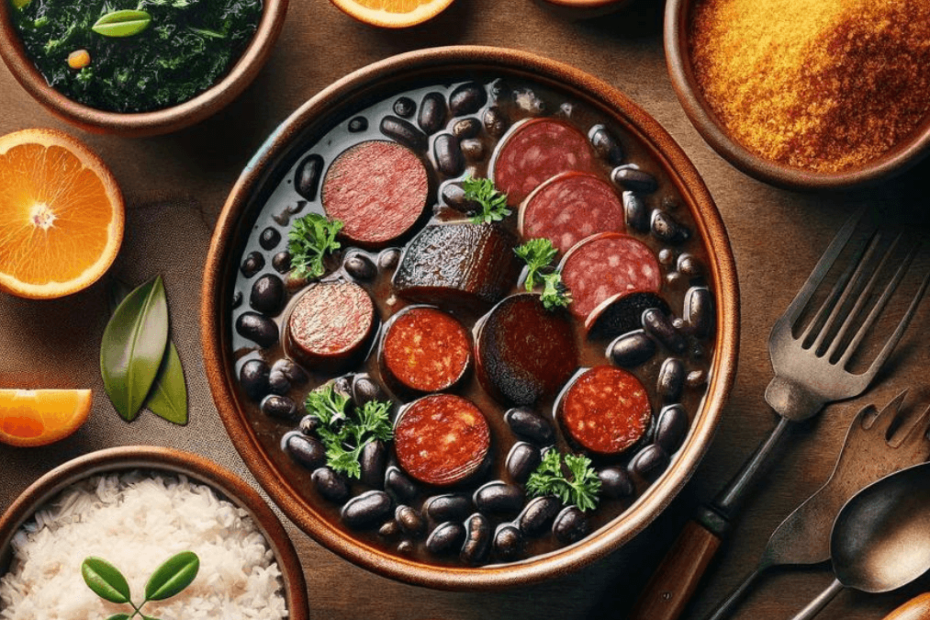Discover the most popular Brazilian food: feijoada, a dish consumed in all regions of the country.
Key Takeaways:
- Feijoada is Brazil’s most beloved dish, epitomizing the country’s rich culinary heritage with its mix of black beans and pork;
- The dish’s origins trace back to Portuguese colonization, symbolizing resilience and creativity through its use of various pork parts and black beans;
- Feijoada is more than food; it’s a cultural event, bringing families and friends together, especially on weekends, emphasizing its role in Brazilian social life;
- The preparation of feijoada is detailed and time-honored, involving overnight soaking of beans and slow cooking, which enriches its flavors and textures;
- Aside from feijoada, Brazilian cuisine boasts other popular foods like coxinha, pão de queijo, brigadeiro, moqueca, farofa, and açaí, showcasing Brazil’s diverse and vibrant culinary landscape.
What do you know about Brazilian cuisine? Perhaps you’ve heard of açaí, or the famous Caipirinha drink.
What if I told you that there’s one dish that Brazilians will probably always point to as the country’s main dish if you ask them “what’s the most popular Brazilian food?”
That’s the dish I’m going to talk about today, come and dive into the roots of Brazilian cuisine with me!
What is The Most Popular Brazilian Food?
Feijoada is most popular food in Brazil, a stew of black beans and pork served with rice, braised cabbage, farofa and sliced oranges.
Feijoada: A Culinary Journey through Brazil
Feijoada’s roots can be traced back to the times of Portuguese colonization, with influences that span across continents. A comforting stew of black beans and a variety of pork parts, it’s a dish that tells a story of resilience, adaptation, and creativity.
From the sun-drenched beaches of Rio de Janeiro to the bustling streets of São Paulo, feijoada is celebrated with equal fervor, albeit with regional twists that make each experience unique.
Its global popularity underscores not just the diaspora’s love for their homeland but also the world’s growing fascination with Brazilian culture.
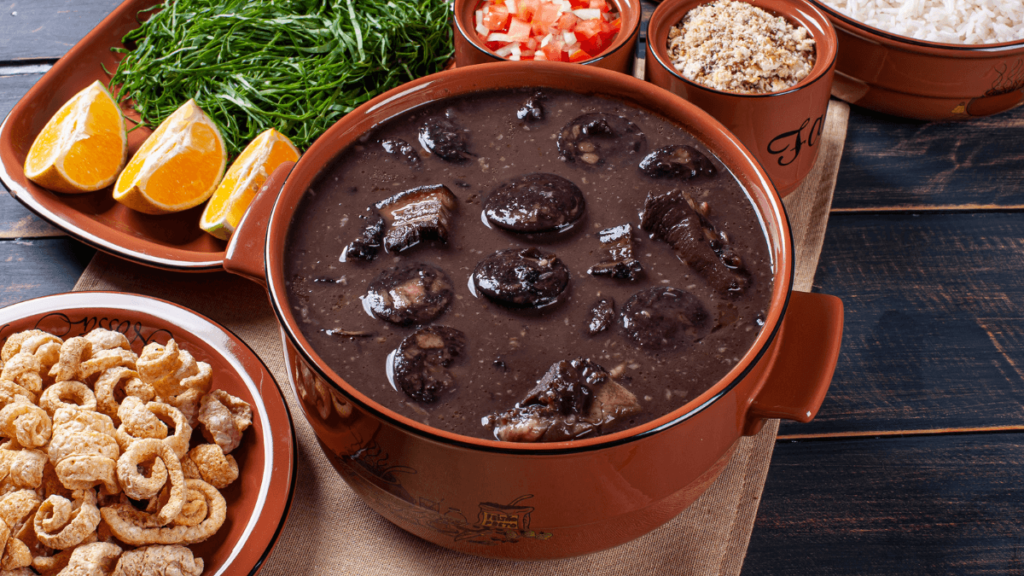
Crafted with ingredients that once were considered leftovers, feijoada turned necessity into a culinary art form.
The dish typically includes flavorful components like salted pork, ears, tail, and feet, paired with the rich texture of black beans.
This combination, slow-cooked to perfection, creates a deep, complex flavor profile that is both nourishing and soul-warming.
Plan your trip to Brazil
More Than Just a Meal: The Cultural Tapestry of Feijoada
But feijoada is more than its ingredients; it’s a celebration, a reason for family and friends to gather around the table on a leisurely Saturday afternoon.
Its preparation is a labor of love, a ritual that begins the night before, with beans soaking and meats being prepped, culminating in a feast that’s as much about togetherness as it is about food.
While feijoada holds a place of pride as a symbol of Brazilian culinary heritage, it’s not an everyday meal. Its richness and the time-intensive preparation make it a dish reserved for special occasions and weekends.
This exclusivity adds to its charm, making each serving a cherished experience that transcends the boundaries of the ordinary.
In Brazil and beyond, feijoada continues to be an ambassador of Brazilian culture, embodying the spirit of diversity, unity, and the joy of life that Brazilians are known for.
So, if you ever find yourself longing for a taste of Brazil, or if you’re simply curious about the rich tapestry of flavors that define this incredible country, feijoada is a perfect start.
It’s not just a dish; it’s an experience, a journey through the heart and soul of Brazil, served up one spoonful at a time, and most likely accompanied by samba.
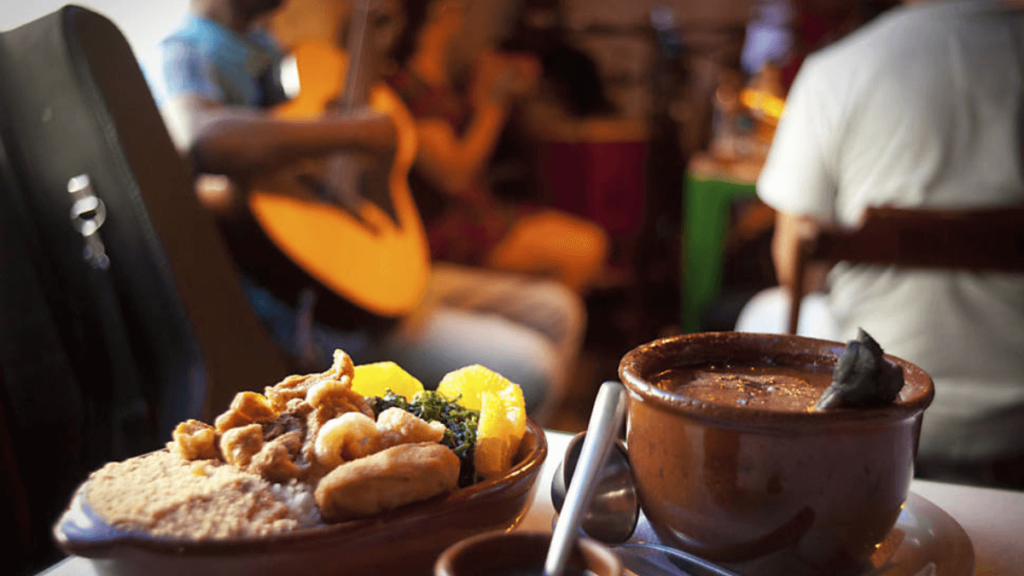
How to make Feijoada?
Feijoada, the soulful stew that encapsulates the essence of Brazil, is a dish that demands patience, love, and a bit of culinary bravery, especially when you dive into its traditional recipe.
This dish is a celebration of flavors, textures, and history, where every ingredient tells a part of Brazil’s story.
The Traditional Recipe
Ingredients:
- 1 lb (450g) dry black beans
- 2 medium onions, finely chopped
- 4 cloves of garlic, minced
- 1/2 lb (225g) salted pork belly, cut into pieces
- 1/2 lb (225g) smoked sausage (such as linguiça or chorizo), sliced
- 1/2 lb (225g) beef or pork ribs
- 1/4 lb (115g) carne seca (dried beef), cut into pieces
- 1 pig’s ear, cleaned
- 1 pig’s tail, cleaned and cut into segments
- 1 pig’s foot, cleaned and quartered
- 2 bay leaves
- Salt and black pepper to taste
- Orange slices, for serving
- Collard greens, finely sliced and sautéed, for serving
- Farofa (toasted cassava flour), for serving
- Cooked white rice, for serving
Preparation:
- Beans Preparation:
- Soak the black beans in a large bowl of water overnight. This softens the beans and reduces cooking time.
- Meat Preparation:
- For salted meats (pork belly, carne seca): Rinse the meats under cold water to remove excess salt. Soak in water for about 2–3 hours, changing the water every hour to further desalinate.
- Boil the pig’s ear, tail, and foot in a separate pot for about 10–15 minutes to clean and soften them.
- Cooking the Feijoada:
- Drain the beans and transfer them to a large pot. Add fresh water to cover the beans by about 2 inches.
- Add the desalinated pork belly, beef or pork ribs, pig’s ear, tail, and foot to the pot. Bring to a boil, then reduce the heat to a simmer, skimming any foam that rises to the surface.
- In a separate pan, sauté the onions and garlic until golden and fragrant. Add the smoked sausage and sauté for an additional few minutes. Transfer this mixture to the pot with the beans and meats.
- Add the bay leaves, salt, and pepper. Simmer the feijoada for approximately 3-4 hours, or until the beans are tender and the meats fall apart easily. Stir occasionally, adding water if necessary, to keep ingredients covered.
- Final Touches:
- Once the feijoada is rich and the meats are tender, adjust the seasoning with salt and pepper to taste. Remove the bay leaves.
- Serving:
- Serve the feijoada hot, accompanied by cooked white rice, sautéed collard greens, orange slices, and farofa for sprinkling on top.
Historical Significance:
The variety of pork parts used in feijoada, such as the ear, tail, and foot, trace back to the dish’s origins with enslaved Africans in Brazil.
These parts were often discarded by slave owners and repurposed into nourishing meals by the slaves, showcasing their ingenuity and resilience.
Over time, feijoada evolved to include more premium cuts of meat, becoming a beloved national dish that symbolizes Brazil’s diverse cultural heritage and culinary richness.
Low-Fat Feijoada Recipe
As feijoada contains many ingredients that are unusual even for Brazilians, it is common for restaurants to serve two versions of it, one containing all the parts of the pig and the other leaner, with common everyday meats.
Ingredients:
- 1 lb (450g) dry black beans
- 2 medium onions, finely chopped
- 4 cloves of garlic, minced
- 1/2 lb (225g) lean pork loin, cut into chunks
- 1/2 lb (225g) turkey or chicken sausage, sliced
- 1/2 lb (225g) smoked turkey breast, cut into chunks
- 2 bay leaves
- 1 teaspoon smoked paprika (to mimic the smoky flavor of traditional smoked meats)
- Salt and black pepper to taste
- 2 tablespoons olive oil (for sautéing)
- Orange slices, for serving
- Collard greens, finely sliced and sautéed, for serving
- Farofa made with whole wheat flour (for a healthier alternative), for serving
- Cooked rice, for serving
Preparation:
- Beans Preparation:
- Soak the black beans overnight in a large bowl of water to soften.
- Meat Preparation:
- Since we’re using leaner meats, there’s no need for desalting. However, to enhance flavor, you might marinate the pork loin and turkey breast in a mix of garlic, salt, pepper, and a bit of lime juice for about an hour before cooking.
- Cooking the Feijoada:
- Drain the beans and transfer them to a large pot. Add fresh water to cover the beans by about 2 inches.
- Heat olive oil in a pan over medium heat. Sauté onions and minced garlic until they are soft and golden. Add the marinated pork loin and turkey or chicken sausage to the pan, browning slightly. Then, transfer this mixture to the pot with beans.
- Add smoked turkey breast, bay leaves, smoked paprika, salt, and pepper to the pot. The smoked paprika helps to impart the smoky flavor characteristic of traditional feijoada.
- Bring the mixture to a boil, then reduce the heat to a simmer. Cook for approximately 3-4 hours, or until the beans are tender and the meats are cooked through. Stir occasionally and add water as necessary to keep the ingredients covered.
- Final Adjustments:
- Once the feijoada is done, adjust the seasoning with salt and pepper to taste. Remove the bay leaves.
- Serving:
- Serve the low-fat feijoada hot, accompanied by cooked rice, sautéed collard greens, orange slices, and a healthier version of farofa made with whole wheat flour.
Vegan Feijoada
As a good Brazilian, I’ve always loved feijoada, but it’s been a few years since I stopped eating meat.
The good news is that it’s also possible to make a vegan feijoada that’s also very tasty!
Ingredients:
- 1 lb (450g) dry black beans
- 2 medium onions, finely chopped
- 4 cloves of garlic, minced
- 1/2 lb (225g) vegan chorizo or plant-based sausage, sliced
- 1/2 lb (225g) smoked tofu, cut into cubes
- 1/2 lb (225g) tempeh or additional smoked tofu, cubed
- 2 bay leaves
- 1 teaspoon smoked paprika
- 1 teaspoon ground cumin
- Salt and black pepper to taste
- 2 tablespoons olive oil (for sautéing)
- Orange slices, for serving
- Collard greens, finely sliced and sautéed, for serving
- Farofa (using olive oil instead of butter), for serving
- Cooked white rice, for serving
Preparation:
- Beans Preparation:
- Soak the black beans overnight in a large bowl of water. This step is crucial for softening the beans and reducing cooking time.
- “Meat” Preparation:
- No need to marinate the vegan meats, but ensure they’re thawed if frozen. The smoked tofu and tempeh will absorb the flavors during cooking, mimicking the texture and taste of traditional feijoada meats.
- Cooking the Feijoada:
- Drain the beans and transfer them to a large pot, covering them with fresh water by about 2 inches.
- Heat olive oil in a large pan over medium heat. Sauté onions and garlic until translucent and fragrant. Add the vegan chorizo, smoked tofu, and tempeh to the pan, cooking slightly to bring out their flavors.
- Transfer the sautéed mixture to the pot with the beans. Add bay leaves, smoked paprika, and ground cumin for that smoky, deep flavor profile characteristic of feijoada.
- Bring to a boil, then reduce the heat to a simmer. Cook for about 3-4 hours, or until the beans are tender. Stir occasionally, adding water as necessary to keep the ingredients submerged.
- Final Adjustments:
- Once the feijoada is fully cooked, adjust the seasoning with salt and pepper. Remove the bay leaves before serving.
- Serving:
- Serve the vegan feijoada hot, accompanied by your choice of white rice, sautéed collard greens, orange slices, and vegan farofa.
Tips for Vegans and Vegetarians:
- Experiment with “Meats”: Feel free to experiment with different vegan meats to find your preferred combination. Jackfruit is another excellent option for its meaty texture.
- Spice it Up: Don’t shy away from using a variety of spices to enhance the flavors. The key to a great vegan feijoada is in the seasoning.
- Savor the Sides: Traditional sides like orange slices, collard greens, and farofa are naturally vegan and complement the dish beautifully, adding texture and freshness.
The Most Popular Daily Brazilian Food
Feijoada is certainly the most popular Brazilian food and the one that most represents Brazil, but as you’ve already seen, it’s more of a festive dish, which is more suited to weekends.
On a day-to-day basis, when Brazilians stop for lunch, one dish is the absolute champion: rice and beans (arroz e feijão).
Rice cooked and seasoned with garlic and beans served as a broth on top of the rice are the perfect combination for a Brazilian.
I, for example, eat rice and beans every weekday, they are the basis of my dish and that of millions of Brazilians, as the days go by we just change the side dishes, such as protein and salad.
I know it can be strange to eat the same thing every day, but I’ve never met a Brazilian who got sick of the combination of rice and beans, but I’ve met several who missed it after just a few days without it.
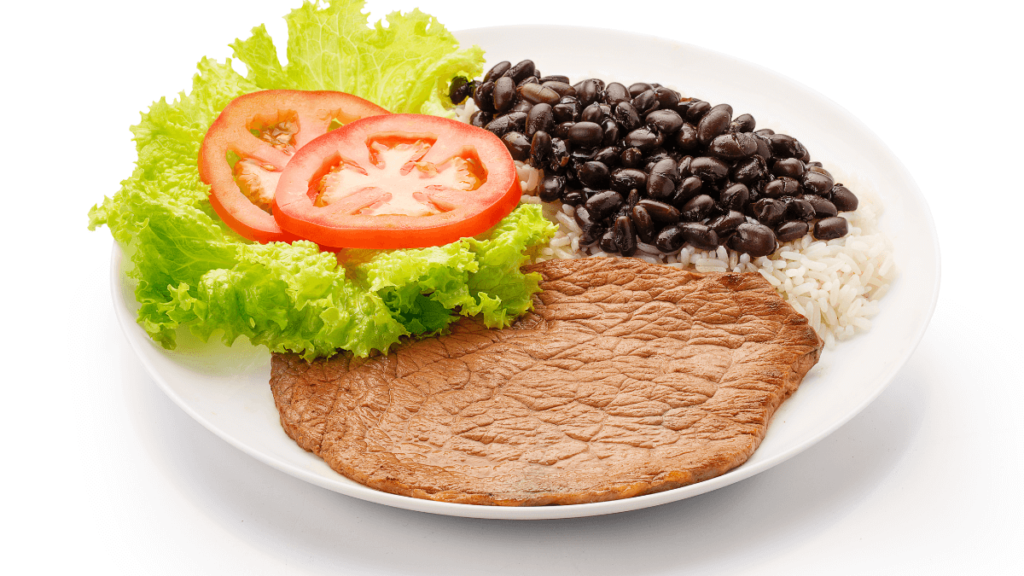
Other Very Popular Brazilian Foods
Brazil’s culinary landscape is as diverse and vibrant as its lush rainforests and bustling cities. Beyond the staple of arroz com feijão and the celebrated feijoada, there are numerous other dishes and treats that hold a special place in the hearts of Brazilians.
Each of these foods tells a story, a piece of the cultural mosaic that makes Brazil truly unique.
Coxinha
Coxinha is a beloved Brazilian snack that resembles a teardrop, a savory gem filled with shredded chicken and encased in a golden, crispy breadcrumb shell.
It’s the ultimate comfort food, found in corner bakeries and households across the country, often enjoyed as a bite-sized treat that brings a sense of nostalgia and warmth with every bite.
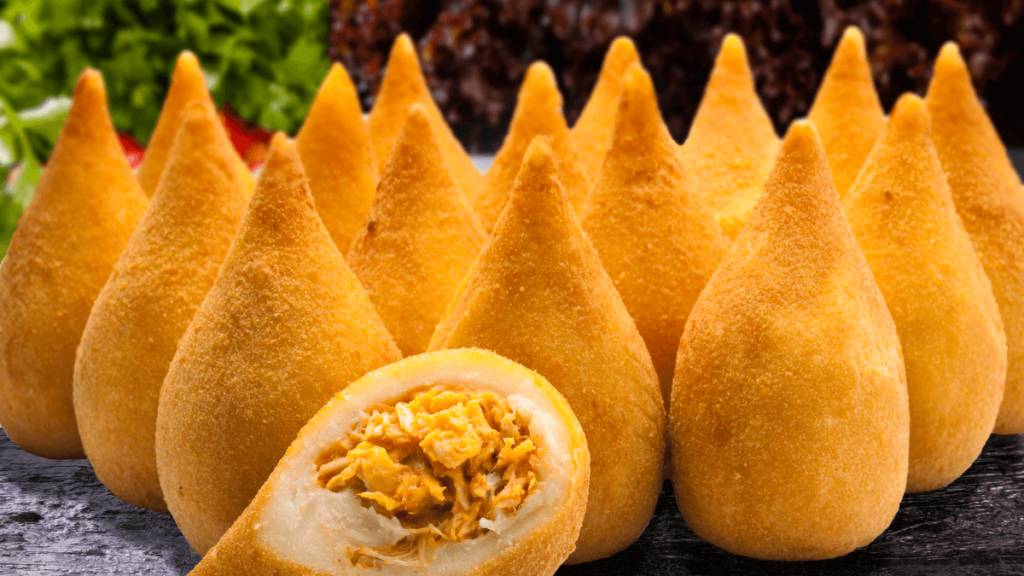
Pão de Queijo
Pão de queijo, or cheese bread, is a gluten-free delight that combines the chewiness of tapioca flour with the richness of cheese, resulting in airy, fluffy balls of goodness.
This snack is a staple at Brazilian breakfast tables and coffee breaks, embodying the warmth and welcoming spirit of Brazilian hospitality.
Brigadeiro
No Brazilian party is complete without brigadeiros, the quintessential Brazilian sweet.
These chocolate fudge balls, rolled in chocolate sprinkles, are more than just a dessert; they are a celebration of life’s sweet moments, shared between friends and family during gatherings and festivities.

Moqueca
Moqueca is a fragrant fish stew that epitomizes the coastal regions of Brazil. It’s a colorful concoction of fish, tomatoes, onions, garlic, and coriander, simmered in coconut milk and dendê (palm oil), reflecting the Afro-Brazilian heritage of the dish.
Moqueca is a testament to Brazil’s rich coastal bounty and its ability to bring the sea’s flavors to the dinner table.
Farofa
Farofa, a toasted cassava flour mixture, is the ultimate Brazilian side dish, providing a crunchy texture contrast to the many soft and stewed components of Brazilian cuisine.
Often cooked with bacon, onions, and spices, it’s a versatile accompaniment that adds a dash of flavor and tradition to any meal.
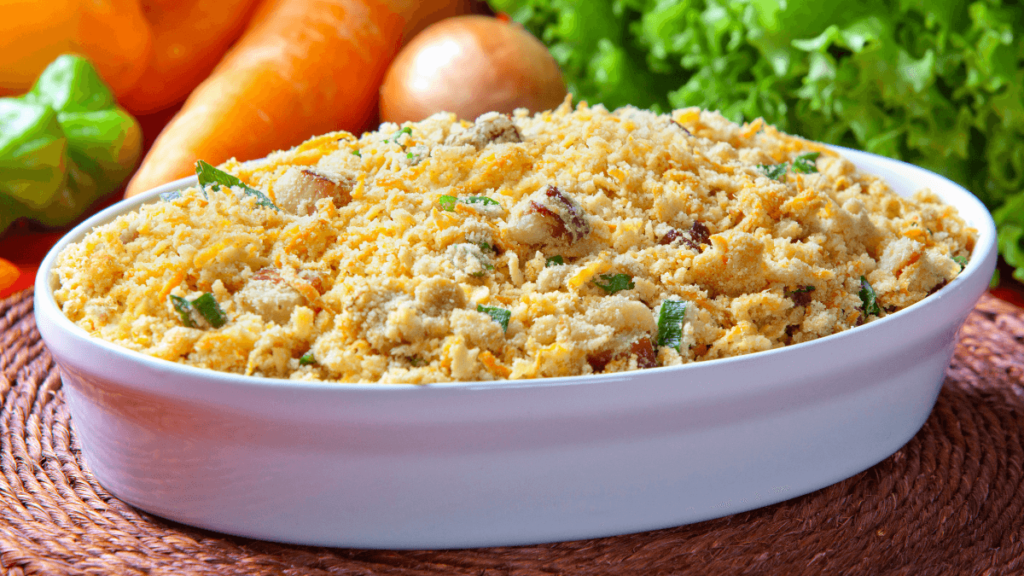
Açaí
Açaí, the superfood berry from the Amazon, has gained international fame for its health benefits, but in Brazil, it’s been a staple long before the trend.
Served as a thick, icy slurry often topped with granola, bananas, and other fruits, açaí bowls are not just a treat; they’re a refreshing escape from the tropical heat, embodying the essence of the Amazon’s natural bounty.
Where to eat Feijoada, the most popular brazilian food, in Rio De Janeiro or São Paulo
Feijoada is a dish consumed all over Brazil, wherever you are it’s very likely that you’ll find a bar or restaurant serving it during lunchtime on Saturdays.
Here are some recommendations for good places to try this dish in Brazil’s two largest cities.
Rio de Janeiro
In Rio de Janeiro, Casa da Feijoada stands out as a must-visit for feijoada enthusiasts. Located next to the Ipanema square, this restaurant specializes in authentic feijoada, served daily, making it a favorite for both locals and tourists.
Another notable mention is Bar do Mineiro in the charming neighborhood of Santa Teresa, famous for its delicious feijoada and a wide selection of cachaça
São Paulo
In São Paulo, a city renowned for its diverse and rich culinary scene, finding the best feijoada, Brazil’s beloved national dish, is a gastronomic adventure. One of the most recommended spots for indulging in this traditional stew is Bolinha.
Established in 1946, Bolinha has earned a reputation for serving some of the best feijoada in town, captivating both locals and visitors with its authentic flavors and hearty servings.
The restaurant offers a unique experience that not only highlights the traditional components of feijoada but also provides variations like the “magra” version, which focuses on the leaner parts of the pork, catering to a wider range of palates.
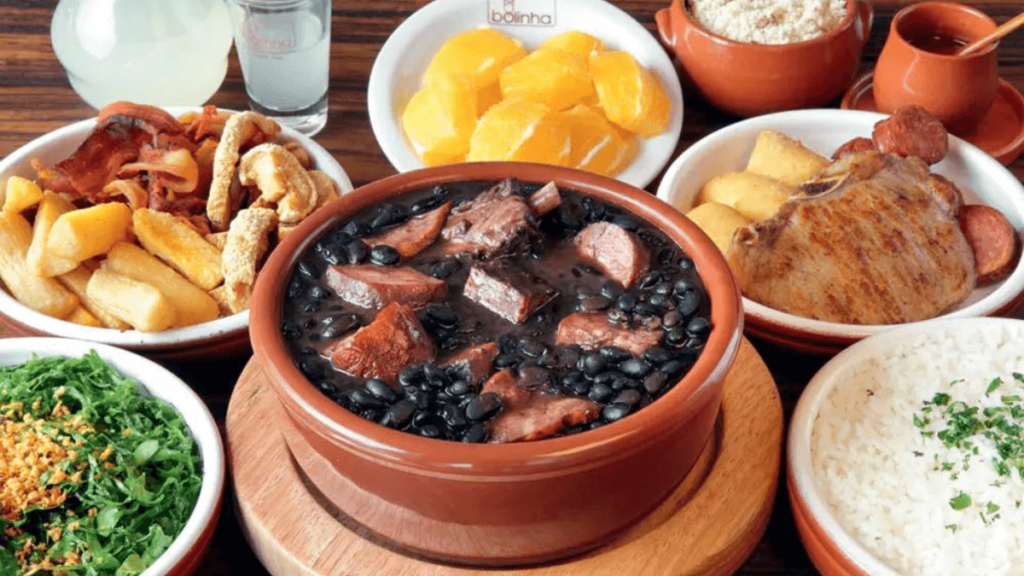
Embracing Brazil’s Culinary Heritage
As we conclude our gastronomic journey through Brazil, it’s clear that the country’s cuisine is a reflection of its heart and soul.
The stories behind dishes like feijoada, the most popular Brazilian food, showcase a rich tapestry of history, cultural fusion, and communal values that define Brazilian life.
From the bustling markets of Salvador to the lively streets of São Paulo and Rio, each meal is a celebration, a way to connect with Brazil’s vibrant spirit. As we savor these flavors, we’re reminded of the power of food to bring people together, creating memories and fostering a sense of belonging that transcends borders.
Did you like our content, do you want to get to know our country?! Discover the best experiences to live in Brazil!
